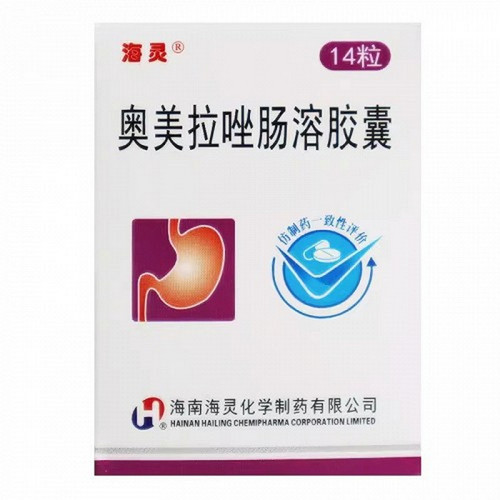Product Overview
[Drug Name]
Generic Name: Omeprazole Enteric-Coated Capsules
Trade Name: Nuojiekang Omeprazole Enteric-Coated Capsules 20mg*14 tablets
Pinyin Code: NuoJieKang AoMeiLaZuoChangRongJiaoNang 20mg*14Li
[Main Ingredients]
The main ingredient of this product is omeprazole, whose chemical name is 5-methoxy-2-[(4-methoxy-3,5-dimethyl-2-pyridyl)-methyl]-sulfinyl)-1H-benzimidazole. Molecular Formula:
C17H19N303S Molecular Weight: 345.42
[Properties]
This product consists of white or off-white enteric-coated pellets.
[Indications/Main Functions]
It is indicated for gastric ulcers, duodenal ulcers, stress ulcers, reflux esophagitis, and Zollinger-Ellison syndrome (gastrinoma).
[Specifications]
20mg*² (14 tablets)
[Dosage and Administration]
Oral administration, do not chew. 1. Peptic ulcer: 20mg (1 tablet at a time), 1-2 times daily. Take in the morning or once in the morning and evening. The treatment course for gastric ulcers is usually 4-8 weeks, and for duodenal ulcers is usually 2-4 weeks. 2. Reflux esophagitis: 20-60mg (1-3 tablets at a time), 1-2 times daily. Take in the morning or once in the morning and evening. The treatment course is usually 4-8 weeks. 3. Zollinger-Ellison syndrome: 60mg (3 tablets at a time), once daily. The total daily dose can be adjusted to 20-120mg (1-6 tablets) depending on the condition. If the total daily dose exceeds 80mg (4 tablets), it should be taken in two divided doses.
[Adverse Reactions]
This product is well tolerated. Common adverse reactions include diarrhea, headache, nausea, abdominal pain, flatulence, and constipation. Rarely, elevated serum aminotransferases (ALT, AST), rash, dizziness, drowsiness, and insomnia may occur. These adverse reactions are generally mild, resolve spontaneously, and are unrelated to dose. No serious adverse reactions have been observed with long-term treatment, but gastric mucosal cell hyperplasia and atrophic gastritis may occur in some cases.
[Contraindications]
This product is contraindicated in patients with allergies, severe renal insufficiency, and infants.
[Drug Interactions]
1. Omeprazole can create an alkaline environment in the stomach, reducing the absorption of drugs such as ketoconazole and itraconazole. 2. When omeprazole is used in combination with clarithromycin or erythromycin, their blood concentrations may increase. However, there is no interaction with metronidazole or amoxicillin. 3. Omeprazole has enzyme inhibitory effects. When used in combination with drugs metabolized by the hepatic cytochrome P450 system (CYP2C19), such as dicoumarol, warfarin, diazepam, and phenytoin, it can prolong the latter's half-life and slow their metabolism. 4. Omeprazole's acid-suppressing effect can affect iron absorption. 5. Omeprazole can alter gastric pH, thereby damaging sustained-release and controlled-release formulations and accelerating drug dissolution. 6. Omeprazole and Other Drug Interaction Studies have shown that daily oral administration of 20-40 mg of omeprazole does not affect other related CYP isoenzymes and has no metabolic interactions with the following enzyme substrates: CYP1A2 (caffeine, phenacetin, theophylline), CYP2C9 (S-warfarin, piroxicam, diflofenac, and naproxen), CYP2D6 (metoprolol, propranolol), CYP2E1 (ethanol), and CYP3A (lidocaine, quinidine, estradiol, and budesonide).
[Precautions]
1. Use with caution in patients with renal or severe hepatic impairment. 2. Effects of the drug on diagnosis: ① Omeprazole may inhibit gastric acid secretion, increasing gastric pH and, in turn, triggering the secretion of gastrin by G cells in the gastric mucosa. Thereby increasing the level of gastrin in the blood; ② Omeprazole can cause a false negative result in the 13C-urea breath test (UBT), and its mechanism may be that omeprazole has a direct or indirect inhibitory effect on Helicobacter pylori (Hp). Clinically, the 13C-urea breath test should be performed at least 4 weeks after omeprazole treatment. 3. Items that should be checked or monitored before, after, and during medication: ① Efficacy monitoring. When treating peptic ulcers, an endoscopic examination should be performed to understand whether the ulcer has healed; when treating Hp-related peptic ulcers, a UBT test can be performed 4 to 6 weeks after the completion of treatment to understand whether Hp has been eradicated; when treating Zollinger-Ellison syndrome, the basal gastric acid secretion value should be tested to see if it is less than 10mEq/h (ie, the treatment target). ② Toxicity monitoring. It should be determined Regular liver function tests are recommended. Long-term users should also have their gastric mucosa checked for tumor-like hyperplasia. Serum vitamin B12 levels should also be monitored for users taking the drug for more than three years. 4. When treating gastric ulcers, this drug should be used only after the possibility of cancer has been ruled out. This medication may alleviate symptoms and thus delay treatment. 5. To prevent excessive acid suppression, long-term, high-dose use of this drug is not recommended for the treatment of general peptic ulcers (except in Zollinger-Ellison syndrome).
[Pediatric Use]
There is no experience with this drug in children. It is contraindicated in infants and young children.
[Elderly Use]
Generally, this drug does not require dosage adjustment in the elderly, but should be used with caution.
[Overdose]
1. Symptoms of overdose include: blurred vision, confusion, sweating, drowsiness, dry mouth, facial flushing, headache, Nausea, tachycardia, or arrhythmia. 2. Overdose Management: Primarily symptomatic and supportive care. Omeprazole is not easily dialyzable; accidental overdose should be treated immediately.
[Pharmacology and Toxicology]
Proton pump inhibitor. This drug is a lipid-soluble, weakly alkaline drug that is easily concentrated in acidic environments. Therefore, after oral administration, it is specifically distributed in the secretory tubules of the gastric mucosal parietal cells. In this highly acidic environment, it is converted to its active form, the sulfenamide. It then irreversibly binds to the sulfhydryl group of the H+,K+-ATPase (also known as the proton pump) in the parietal cell secretory membrane via a disulfide bond, forming a sulfenamide-proton pump complex. This complex inhibits the enzyme's activity and blocks the final step in gastric acid secretion. Therefore, this drug has a strong and long-lasting inhibitory effect on gastric acid secretion caused by various reasons.









